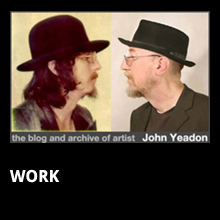Lesson 9
Like graffiti in a lift
I once asked a student about their work and they trotted out a clearly over-rehearsed answer, that they “could not answer the question as their artwork worked on many levels“.
Suspecting that this answer was just to avoid answering the question, I asked them to “name three”of these levels. Three being the smallest number of ‘many’, inevitably they could not name one.
Like graffiti in a lift, art works on many levels!
However, I dislike the use of the word ‘level’ as that implies a hierarchy of meaning. Art working as a metaphor resonates, and makes reference to many things which are dependent on what the audience brings to it. No art can be truly self-referential. All art is referential.
These levels are clear, aesthetic, sociological, political, ethnographic, autobiographical, historical, etc. There are no excuses for not knowing three interpretations of anything.
The understanding that a painting should be ambiguous, should leave room for the viewer’s imagination is a fashion, what is out of fashion is the didactic painting. It seems that didactic art is seen as against art that is a metaphor, but didactic art is often metaphorical. What else is Michelangelo’s Sistine Chapel?
I have heard artists explaining their work, usually recounting their personal ‘back story’ and then saying that the work is open to the audiences’ imagination. Clearly, they felt they have to say this even though it may not be true. In the 1960s as an art student I was told to make a statement, that was the fashion of the time. Even then I was aware that painting could not tell you anything new unless you were open to it, painting supported your views, you saw what you brought to it. The other side of the coin of the viewer’s imagination is what the viewer brings to the art, the baggage they bring to the art. Your enthusiasms and prejudices are unconsciously stated.
However, I do think painting even didactic art can act as a trigger, a trigger to thought.
We have a spectrum, at one end is the didactic work of art, propaganda, close by Agit Prop, in the middle self- referential art, the sort of painting that was described as the ‘purely visual’, leading to the conceptual where no object is necessary, not even a pointing finger, just an idea and an audiences imagination, where everybody is an artist etc.
You like what you understand, it is not “I know what I like” but “I like what I know”.
Art reinforces opinion, rarely changes opinion, rarely informs like literature. I have often read something and thought, “I never knew that” but never thought that in front of a painting, “I never knew that!“. This notion of art reinforcing already established views is central to the debate on didactic art and whether art can change things. Changing, always implies, changing things for the better, I think art more often than not tends to change things for the worse, that is, by upholding the status quo.
Making a statement goes against the grain with much current art practice and didacticism is not popular as it seems to leave out the participation of the viewer. I have been criticised for being too obvious and not leaving enough space for the imagination of the audience. I used to tell my students not to discount the obvious, the obvious can be difficult to deal with but it could be the fundamental, the common denominator, the important thing. You should not dismiss the obvious without investigating it thoroughly. The obvious is not always obvious. The problem with the obvious, like ‘the elephant in the room’, is that it can be invisible, it is ignored, and nobody has given it any thought because it is obvious. Being obvious or just being straightforward about ‘subject’ or art is not the easy option.
However, obscurantism always rules the day.
This Art Lesson’s exercise: Make an artwork that ‘operates’ just on one level.
This entry was posted on Tuesday, November 3rd, 2015 at 9:00 am
You can follow any responses to this entry through the RSS 2.0 feed.
